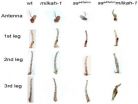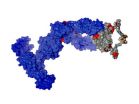(Press-News.org) Exploding supernovae are a phenomenon that is still not fully understood. The trouble is that the state of nuclear matter in stars cannot be reproduced on Earth. In a recent paper published in EPJ E, Yves Pomeau from the University of Arizona, USA, and his French colleagues from the CNRS provide a new model of supernovae represented as dynamical systems subject to a loss of stability, just before they explode. Because similar stability losses also occur in dynamical systems in nature, this model could be used to predict natural catastrophes before they happen. Previous studies of the creeping of soft solids, earthquakes, and sleep-wake transitions have already confirmed the validity of this approach.
The authors show that the stars' loss of stability can be described in mathematical terms as a so-called dynamical saddle-node bifurcation. This approach makes it possible to devise a universal equation describing supernovae dynamics at its onset, taking into account the initial physical conditions of stability. Unlike previous studies, this one sheds light on why the time scale of a supernova explosion—lasting between ten and thirty seconds—is considerably shorter than the overall pace of evolution of the star, in the billion year range.
This study also attempts to elucidate whether supernova explosions are genuine and do not result from a reversed implosion. Indeed, supernovae are believed to be initially subjected to an inward flow—as the star's core may collapse into a neutron star or a black hole—that is subsequently superseded by the violent outward flow of the supernova explosion. The authors attempt to explain this phenomenon through a detailed model, demonstrating that the star enters a global free fall following its loss of stability.
INFORMATION:
Reference: Y. Pomeau, M. Le Berre, P.H. Chavanis, and B. Denet (2013), Supernovae: an example of complexity in the physics of compressible fluids, European Physical Journal E, DOI 10.1140/epje/i2014-14026-1
For more information visit: http://www.epj.org
The full-text article is available to journalists on request.
Stability lost as supernovae explode
A new model accounting for the loss of stability in supernova explosions sheds some new light on this phenomenon
2014-05-15
ELSE PRESS RELEASES FROM THIS DATE:
Marine scientists use JeDI to create world's first global jellyfish database
2014-05-15
An international study, led by the University of Southampton, has led to the creation of the world's first global database of jellyfish records to map jellyfish populations in the oceans.
Scientific and media debate regarding future trends, and subsequent ecological, biogeochemical and societal impacts, of jellyfish and jellyfish blooms in a changing ocean is hampered by a lack of information about jellyfish biomass and distribution from which to compare.
To address this knowledge gap, scientists used the Jellyfish Database Initiative, or JeDI, to map jellyfish biomass ...
Study: Addressing 'mischievous responders' would increase validity of adolescent research
2014-05-15
WASHINGTON, D.C., May 15, 2014 ─ "Mischievous responders" play the game of intentionally providing inaccurate answers on anonymous surveys, a widespread problem that can mislead research findings. However, new data analysis procedures may help minimize the impact of these "jokester youths," according to research published online today in Educational Researcher, a peer-reviewed journal of the American Educational Research Association (AERA).
VIDEO: Author Joseph P. Robinson-Cimpian discusses key findings: http://youtu.be/WFFaA74sygI.
"Inaccurate Estimation of ...
Neural pathway to parenthood
2014-05-15
Good news for Dads: Harvard researchers say the key to being a better parent is – literally – all in your head.
In a study in mice, Higgins Professor of Molecular and Cellular Biology and Howard Hughes Investigator Catherine Dulac have pinpointed galanin neurons in the brain's medial preoptic area (MPOA), that appear to regulate parental behavior. If similar neurons are at work in humans, it could offer clues to the treatment of conditions like post-partum depression. The study is described in a May 15 paper published in Nature.
"If you look across different animal ...
Getting chemo first may help in rectal cancer
2014-05-15
PROVIDENCE, R.I. [Brown University] — First things first. If cancer patients are having trouble tolerating chemotherapy after chemoradiation and surgery, then try administering it beforehand. Reordering the regimen that way enabled all but six of 39 patients to undergo a full course of standard treatment for rectal cancer, according to research to be presented at the American Society for Clinical Oncology annual meeting in Chicago.
Studies have shown that only about 60 percent of rectal cancer patients comply with postoperative chemotherapy, said lead researcher Dr. Kimberly ...
MIPT experts reveal the secret of radiation vulnerability
2014-05-15
The scientists - Boris Kuzin, Ekaterina Nikitina, Roman Cherezov, Julia Vorontsova, Mikhail Slezinger, Olga Zatsepina, Olga Simonova, Grigori Enikolopov and Elena Savvateeva-Popova - studied Drosophila flies, in whose genome weak mutations of two different genes were combined. The paper is published in the PLoS One. They concluded that these mutations synergistically strengthen their mutual phenotypic expression. In other words, the aggregate effect of these mutations is much greater than that which can be produced by one of them individually.
The mutant flies bred by ...
MIPT scientists develop algorithm for anti-aging remedy search
2014-05-15
The scientists – Alexander Zhavoronkov, Anton Buzdin, Andrey Garazha, Nickolay Borisov and Alexey Moskalev– have based the new research on their previously-developed methods in the study of cancer cells. Each cell uses particular schemes of molecular interaction, which physiologists call intercellular signaling pathways.
A signaling pathway is a chain of sequential events of interaction between certain molecules which make the cell respond to stimulation. For example, hormone molecules first interact with the cell's membrane receptors, then the receptors engage with the ...
Next frontier: How can modern medicine help dying patients achieve a 'good' death?
2014-05-15
(TORONTO, Canada – May, 15, 2014) -- The overall quality of death of cancer patients who die in an urban Canadian setting with ready access to palliative care was found to be good to excellent in the large majority of cases, helping to dispel the myth that marked suffering at the end of life is inevitable.
"Fear of dying is something almost every patient with advanced cancer or other life-threatening illness faces, and helping them, to achieve a "good death" is an important goal of palliative care," says Dr. Sarah Hales, Coordinator of Psychiatry Services, Psychosocial ...
Study shows young men increasingly outnumber young women in rural Great Plains
2014-05-15
Lincoln, Neb., May 15, 2014 -- In many rural communities hard hit by decades of population declines, young men increasingly outnumber young women, a new study of Kansas and Nebraska census data shows.
In places with 800 or fewer residents, the proportion of young men increased by an average of nearly 40 percent as people went from their teens to their 20s.
Those findings suggest leaders should consider the needs of young women in their economic and community development plans, said Robert Shepard, a University of Nebraska-Lincoln doctoral candidate ...
Most NHL players peak by age 29: Study
2014-05-15
A new University of British Columbia study identifies when the clock runs out on an NHL player's peak performance, giving team executives insight into how best to build a roster.
The study by Sauder School of Business professor James Brander found that the performance of forwards peaks between the ages of 27 and 28. Defencemen are best between 28 and 29, and the performance of goaltenders varies little by age.
The forthcoming study to be published in the Journal of Quantitative Analysis in Sports also reveals that players performed close to their peak levels for a ...
Learning from sharks
2014-05-15
This news release is available in German.
Custom-tailored antibodies are regarded as promising weapons against a multitude of serious illnesses. Since they can accurately recognize specific structures on the surface of viruses, bacteria or cancer cells, they are already being deployed successfully in cancer diagnostics and therapy, as well as against numerous other diseases. The stability of the sensitive antibodies is a decisive factor in every step, from production and storage to therapeutic application.
A team of researchers headed by Dr. Matthias J. Feige and ...
LAST 30 PRESS RELEASES:
Numbers in our sights affect how we perceive space
SIMJ announces global collaborative book project in commemoration of its 75th anniversary
Air pollution exposure and birth weight
Obstructive sleep apnea risk and mental health conditions among older adults
How talking slows eye movements behind the wheel
The Ceramic Society of Japan’s Oxoate Ceramics Research Association launches new international book project
Heart-brain connection: international study reveals the role of the vagus nerve in keeping the heart young
Researchers identify Rb1 as a predictive biomarker for a new therapeutic strategy in some breast cancers
Survey reveals ethical gaps slowing AI adoption in pediatric surgery
Stimulant ADHD medications work differently than thought
AI overestimates how smart people are, according to HSE economists
HSE researchers create genome-wide map of quadruplexes
Scientists boost cell "powerhouses" to burn more calories
Automatic label checking: The missing step in making reliable medical AI
Low daily alcohol intake linked to 50% heightened mouth cancer risk in India
American Meteorological Society announces Rick Spinrad as 2026 President-Elect
Biomass-based carbon capture spotlighted in newly released global climate webinar recording
Illuminating invisible nano pollutants: advanced bioimaging tracks the full journey of emerging nanoscale contaminants in living systems
How does age affect recovery from spinal cord injury?
Novel AI tool offers prognosis for patients with head and neck cancer
Fathers’ microplastic exposure tied to their children’s metabolic problems
Research validates laboratory model for studying high-grade serous ovarian cancer
SIR 2026 delivers transformative breakthroughs in minimally invasive medicine to improve patient care
Stem Cell Reports most downloaded papers of 2025 highlight the breadth and impact of stem cell research
Oxford-led study estimates NHS spends around 3% of its primary and secondary care budget on the health impacts of heat and cold in England
A researcher’s long quest leads to a smart composite breakthrough
Urban wild bees act as “microbial sensors” of city health.
New study finds where you live affects recovery after a hip fracture
Forecasting the impact of fully automated vehicle adoption on US road traffic injuries
Alcohol-related hospitalizations from 2016 to 2022
[Press-News.org] Stability lost as supernovae explodeA new model accounting for the loss of stability in supernova explosions sheds some new light on this phenomenon




